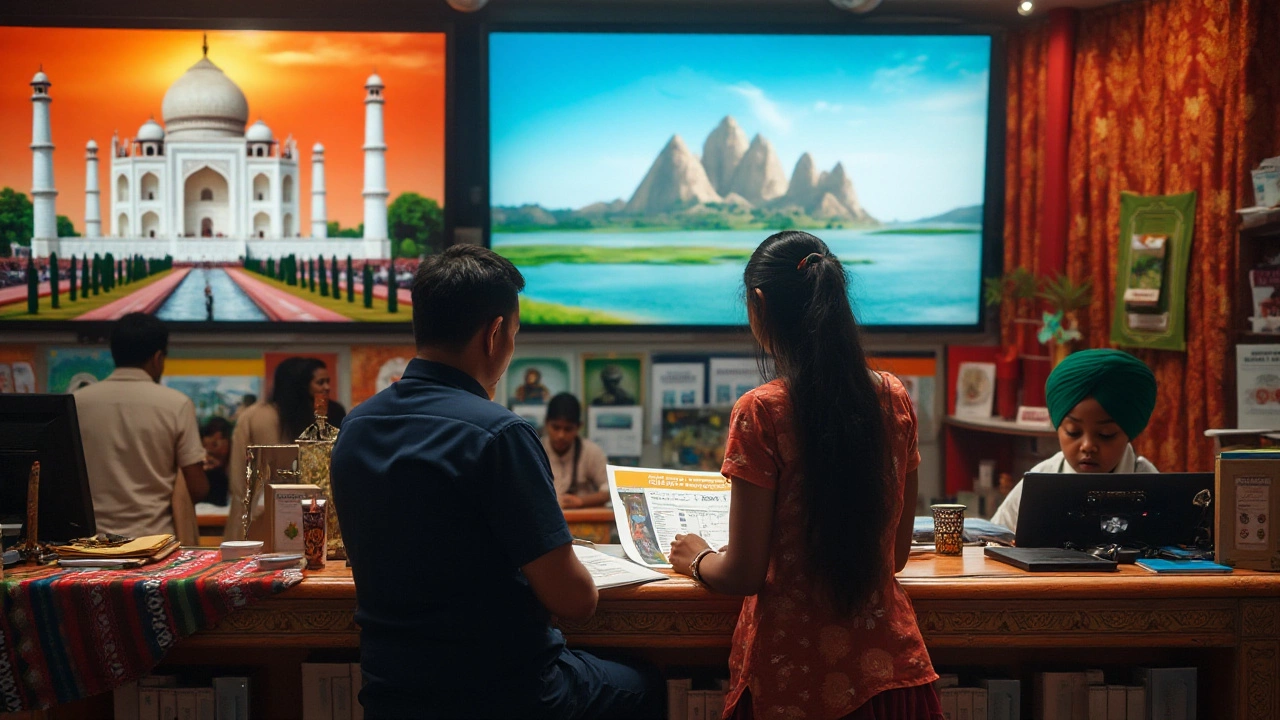Embarking on an adventure to India from the United States involves a fair amount of planning, especially when it comes to acquiring the necessary visa. With an array of options available and fluctuating costs, understanding the process can seem daunting. But don't worry, we've got you covered with everything you need to know in 2025.
From exact costs and hidden charges to valuable travel tips, this guide aims to simplify your journey while keeping an eye on your budget. Whether you're planning to explore the bustling streets of Delhi, the serene backwaters of Kerala, or the vibrant culture in-between, knowing how to navigate the visa expenses can make your trip much more enjoyable.
- Understanding the Indian Visa Categories
- Application Process and Associated Costs
- Additional Fees and Hidden Charges
- Useful Travel Tips for India
- Cultural Insights: What to Expect
- Saving Money on Your Indian Journey
Understanding the Indian Visa Categories
Planning a trip to a land as diverse and vast as India requires some groundwork, starting with understanding the different Indian visa categories available for US citizens. Navigating through the types might seem overwhelming at first due to the variety, but it's fairly simple once you break it down. India's immigration policies offer several visa options, each tailored for various purposes, ensuring that every traveler finds a visa that fits their travel needs. The three most common categories are the Tourist Visa, the Business Visa, and the Employment Visa.
The Tourist Visa is the most popular among US travelers. It allows visitors to experience the rich heritage, natural beauty, and diverse culture that India boasts. Typically valid for a duration of 6 months, it allows single, double, or multiple entries, so you can hop in and out of neighboring regions without a hassle. What truly appeals to globetrotters is India's e-Visa service, which facilitates the visa acquisition process online without physical paperwork. Getting an e-Visa costs approximately $25 to $100, fluctuating based on the duration of stay and number of entries chosen.
For those heading to India to work or engage in business, the Business Visa and Employment Visa are pertinent. These are designed to cater to different scenarios such as attending meetings, conferences, or engaging in commercial sales. The Business Visa, typically valid for up to 5 years, costs about $100 to $160. On the other hand, the Employment Visa is structured around the work contract, providing up to a 5-year stay based on the job. Both these visas require an invitation or employment contract from an Indian entity, adding another layer to the process.
As the Indian government states, 'India's doors are open for business, tourists, and cultural exchange; our visa categories ensure a smooth process for various visits.'
Interestingly, there's also an Intern Visa for students or young professionals looking to intern in India. Then comes the Student Visa for those aspiring to enroll in educational institutes here. Such catering underscores India's emphasis on educational exchange and cultural openness. Additionally, lesser-known visas like the Medical Visa are available for those seeking health treatment in India's globally recognized hospitals. Each category has its specific requirements akin to documentation, invitation letters, or proof of employment.
Application Process and Associated Costs
For US citizens, navigating the application process for an Indian visa can feel like deciphering an intricate puzzle. But fear not, it's a journey worth embarking upon for those enchanted by the promise of India’s vibrant culture and breathtaking landscapes. First, it's essential to identify the type of visa you need. India offers various visas, including tourist, business, medical, and e-visas, each with its own cost implications and processing times. The tourist visa remains the most popular choice among US travelers swooning for a taste of India, whether it’s the historic forts or lush landscapes.
Applying for an Indian visa involves a few crucial steps. To begin, you’ll need to access the Indian Government’s official visa website and fill out the online application form. This may include scanning a recent photograph and your current passport. Next, the process demands that you schedule an appointment at your local visa center to submit your documents and biometric data. Depending on the type of visa, you should be prepared to invest time in a meticulous document preparation process, ensuring everything is in order to avoid delays.
When it comes to costs, an Indian visa for US citizens settles around $100 to $200 as of 2025, depending on the visa's duration and validity. Note that these fees are subject to change, and it is advisable to check the most current information directly from official resources before planning your trip. Additional charges can accrue; these might include service charges, biometric fees, or expedited processing, should you find yourself in a pinch for time.
Interestingly, a significant number of travelers opt for the e-visa option due to its convenience and lower cost, typically around $80. The e-visa allows visitors to enter India for tourism, business, or medical purposes and is valid for a shorter duration, usually up to 60 days with double entry access. The ease of applying online and receiving the visa electronically has considerably boosted its popularity. However, always ensure the email address provided is accurate, as it will be the primary medium for receipt and communication.
In a quote encapsulating the essence of India’s appeal, celebrated in traveler’s lore,
“India captivates and confounds in equal measures, but unravel its wonders and it becomes the journey of a lifetime.”These words remind us why so many embark on this visa application voyage. The process, while seemingly complex, is a gateway to experiencing riches both material and intangible. Remember, patience and precision are your allies when navigating the Indian visa application process for a seamless start to your adventure.

Additional Fees and Hidden Charges
When planning a trip to India, understanding the additional fees and hidden charges associated with obtaining an Indian visa is crucial for maintaining a solid travel budget. Quite often, travelers underestimate these extra costs, which can lead to financial surprises later on in their journey. These fees are typically not included in the initial application price, and they crop up in various forms. For instance, depending on the processing speed you choose, expedited services can significantly bump up the expenses. If you're in a hurry, opting for express service might seem appealing. However, it's important to factor in that these express fees can sometimes double the original visa cost.
Beyond the expedited service fees, you should also be cautious of processing fees charged by third-party agencies if you're not applying directly through the Indian government's official website. These agencies often promise a hassle-free application experience and operate as middlemen, but they charge a premium for their service. Such costs can sometimes run into double digits, adding up quickly when other family members are involved in the travel plans.
Moreover, travelers may encounter additional charges when making online payments. Credit card transaction fees can apply depending on your financial institution or the payment gateway being used. It's advisable to check with your bank about any international transaction fees to avoid surprises. A surprising number of travelers overlook this simple yet effective check. For instance, one traveler noted, "It wasn't until I received my credit card statement that I realized just how much these small fees added up. A little foresight could have saved me a chunk of unexpected expenses."
It's also worth noting any consular service charges that might apply when making inquiries or requests. Some embassies and consulates have specific charges for certain services, such as documentation or notary confirmation, which can be unavoidable in some scenarios. Keeping an eye out for these additional fees ensures you're adequately prepared, avoiding any potential hiccups during your grand adventure to the vibrant tapestry that is India.
Useful Travel Tips for India
Traveling to India promises a kaleidoscope of experiences that can be incredibly enriching. To make the most out of your trip, it's crucial to embrace the country's nuances with both open arms and an open mind. One of the valuable pieces of advice is to plan your itinerary wisely with a focus on the season; knowing when to go can make your experience vastly different. The best time to visit the majority of the country is between October and March, avoiding the extreme heat and monsoon periods. Yet, if you are heading to the Himalayan regions, consider the summer months of May through September. India is tremendous in its diversity, so packing appropriately based on regions you plan to visit is essential, from the frigid north to the sun-kissed South.
Communication can be smoother than expected, as English is widely spoken, especially in urban areas and tourist spots. However, learning a few basic words in Hindi or the regional language can enhance your interactions with locals and express friendly respect towards their culture. This affection for language only grows when you dive into the heart of India's culinary treasures. Sampling street food is an unmissable experience, but ensure it's served fresh and from stalls that are bustling with locals. Whether you're trying the spicy Pani Puri or the sweet Jalebi, it's important to keep your health in check by carrying hand sanitizers. Your body might take time to adjust, so pepper your new dishes with a dose of caution.
Getting around India can be an adventure in itself. For short distances, auto-rickshaws and cycle-rickshaws offer a peek into local livelihoods, while for longer journeys, the vast rail network is both an economical and intriguing way to see the country, known for its 'India Railways'. Always book in advance to secure your seats, especially during peak tourist seasons. If safety is at the fore of your mind, remember that like anywhere in the world, it's about being vigilant and using common sense. Avoid isolated areas at night and safeguard your belongings.
The cultural fabric of India is woven with festivals and traditions, so timing your trip to coincide with events such as Diwali, Holi, or even smaller folk festivals in villages can offer deep insights into its vibrant traditions. These are not just festive occasions but narratives of India’s ethos and values. Keep an ear out for local tours or experiences that emphasize responsible tourism, as they often offer genuine, enriching stories about the larger-than-life country.
"Travel brings power and love back into your life." - Rumi
Budget travelers will find India a welcome sanctuary for their pockets, but being a smart spender is key. Always carry small denominations, for they come in handy at local markets and small eateries. Haggling is an art here, and it's generally expected at local bazaars. However, do so with respect and a smile, recognizing the livelihood of those whose shops you browse. Remember, this is a country that thrives on its sense of hospitality – from guesthouses that open their arms with warmth to the chai-wallah who serves up delightful conversations with each cup. It's all about leaving behind the mundane, embracing surprises, and carrying back stories that brighten any day.

Cultural Insights: What to Expect
As you embark on your Indian journey, it becomes essential to embrace the tapestry of diverse cultures, traditions, and experiences that await you. India isn't just a place; it’s an experience that overwhelms your senses in the most magnificent ways. From the aromatic spices that dance through bustling markets to the vibrant hues of traditional attire, the subcontinent is a rich mosaic of history and modernity. The cuisine alone is a voyage through flavors and history, each dish offering a story in every bite.
An interaction with locals reveals India's intrinsic spirit of hospitality, a tradition rooted in the ancient Sanskrit saying “Atithi Devo Bhava,” which means “The guest is God.” Whether in bustling metropolitan cities or tranquil rural landscapes, the generosity and welcoming nature of Indians often leave visitors humbled and charmed. You might find yourself invited to a family meal or joining in an impromptu celebration, and it is in these moments that the heart of India truly reveals itself. Indians, irrespective of regional differences, hold their guests in special regard, often going the extra mile to ensure they feel at home.
Spirituality weaves itself into daily life in India, with a medley of religions coexisting harmoniously and influencing the country’s architecture, festivals, and daily life. Icons of faith, from the sublime tranquility of a Buddhist monastery in Ladakh to the reverence surrounding the Golden Temple in Amritsar, offer profound glimpses into the sacred fabric of the land. A vibrant calendar of festivals illuminates the year, with massive celebrations like Diwali, Eid, and Holi, where streets burst with color, lights, and exuberance. A quote from acclaimed travel writer Pico Iyer captures this essence:
‘We travel, initially, to lose ourselves; and we travel, next, to find ourselves. We travel to open our hearts and eyes and learn more about the world than our newspapers will accommodate.’
The geographical diversity of India adds another layer to its cultural allure. The north presents the ethereal beauty of the Himalayas, sprinkled with monasteries that invite both trekking trails and spiritual journeys. The southern coastlines feature pristine beaches and coconut groves, where time seems to slow down. Eastwards, one encounters ancient tribal cultures in the hills and vibrant tea plantations, while the west narrates tales of deserts and royalty. Each region stands as a microcosm of cultures, offering different narratives and unique traditions.
Travel to India offers lessons in coexistence and harmony, as the nation gracefully balances modern innovations with age-old traditions. Entering a metropolitan city like Mumbai or Delhi, you experience a dizzying blend of the past and future - ancient bazaars thriving alongside luxurious malls and heritage sites standing sentinel amid high-rise wonders. Whether you choose the spiritual paths or modern marvels, India promises an unforgettable journey filled with insights and personal growth.
Saving Money on Your Indian Journey
Exploring India can be an incredible experience without breaking the bank, provided you know some key tips and tricks. Surprisingly, many people discover that India offers a multitude of opportunities to keep your expenses minimal while maximizing your adventures. First and foremost, let’s talk about accommodation, which can vary widely in price. Hostels, guesthouses, and budget hotels offer a chance to stay without heavy financial strain. Websites like Hostelworld and Booking.com frequently have great deals that cater to every budget traveler. Make note, though, that booking in advance during peak travel season might help avoid inflated prices. Meanwhile, transportation in India is another area ripe for saving. The extensive railway system is both iconic and affordable, with sleeper classes being particularly cheap. The trick is to book in advance—Indian Railway Catering and Tourism Corporation (IRCTC) allows tickets to be booked up to 120 days beforehand, ensuring cheaper rates.
Food is another aspect where travelers can conserve funds. India’s street food is legendary, offering delicious bites at fraction of restaurant costs. Not only does this stretch your budget, but it also provides an opportunity to indulge in authentic local flavors. However, ensuring the food is fresh and hygienic is key; opt for stalls bustling with locals, indicating both popularity and freshness. Transitioning to exploring the sights, an incredibly economical habit is aligning your itinerary with the plethora of free activities available. From public parks and vibrant markets to breathtaking temples that don’t charge admission fees, there’s no shortage of attractions that showcase India’s soul. Even some museums offer free entry on specific days; timing your visit just right can yield significant savings. Prepare to be amazed by what you can experience without spending a dime.
Speaking of itineraries, here are tips for optimizing your spending further. Although tempting, do not exchange currency at airports—rates tend to be less favorable. Instead, utilizing local banks or ATMs for better conversion rates is advisable. Be mindful of any international transaction fees imposed by your bank and plan accordingly. Some banks may waive fees if informed of travel in advance. Additionally, shopping in India can be a delightful experience, but haggling is expected in most local markets. With a little practice, negotiating prices can be both a fun and financially rewarding endeavor. Remember, if you’re respectful and fair in your approach, you're more likely to positively engage with vendors, leading to better outcomes. For a different perspective, consider this insight from travel writer Rick Steves:
"Travel like you're a temporary local, not a privileged tourist. The world opens up in unexpected ways, and your wallet will thank you."
Lastly, it’s worth discussing SIM cards and mobile data plans. Although daunting at first, purchasing a local SIM card is well worth the effort. Data costs in India are among the cheapest worldwide, providing extensive connectivity on a budget. Companies like Airtel and Jio offer various plans to accommodate different needs. This ensures access to maps, ride-sharing apps, and communication without reliance on often unreliable public Wi-Fi. As you navigate through this vibrant country, these tangible savings will add up, allowing for unforeseen adventures and perhaps even an unexpected splurge or two. From finding cost-efficient accommodations to enjoying low-cost culinary delights, traversing India on a budget is not only feasible but incredibly fulfilling. By putting these suggestions into practice, you'll enrich your journey while preserving resources for future travels.
